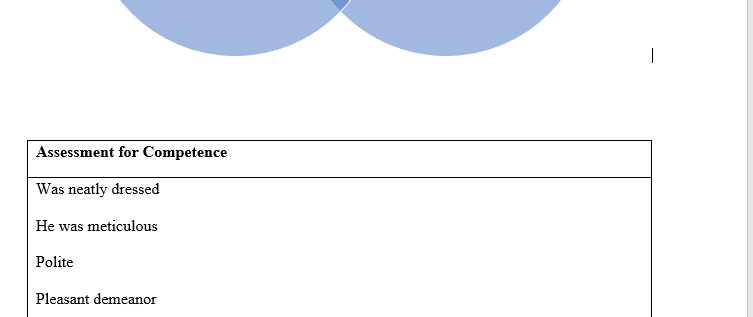Identify the Biological, Psychological, and Social variables impacting the client. Utilizing the information learned from this week’s
Learning Goal: I’m working on a writing case study and need guidance to help me learn.
Biopsychosocial #5
Utilizing the information learned from this week’s chapter and reviewing the case examples in the text for practice, review the case below to:
a) Identify the Biological, Psychological, and Social variables impacting the client
b) Assess for Competence
Students must complete this assignment using two formats:
1) Submit the attached form/diagram which is similar to the examples used in the text. The diagram should be completed using applications from the case vignette listed below and provide a “snapshot” of your assessment. Examples from the chapter can be used for reference.
2) Submit written feedback using APA 7th edition format with the 3 variables (bio/psycho/social) and competence utilized as headers. This submission should include an expansion of the assessment diagram and provide support to the assessment given utilizing information from the text and any other empirically supported sources. Submissions for this assignment should include a title and reference page along with proper APA format which includes in-text citations, double space, 12 font, Time New Roman, etc. Excluding the title and reference page, your response should be approximately 1-2 pages in length.
Biopsychosocial Diagram.docx Download Biopsychosocial Diagram.docx
Case Vignette
Winston was an 85-year-old white male who was taken to the psychiatric emergency room (ER) by paramedics after they had been called to his residence by neighbors when they identified an odd smell. Apparently, his 87-year-old sister had passed away a few days earlier after a long illness. Winston had not reported her death due to becoming very disorganized as his sister’s health worsened. He was worried that his landlord would use the apartment’s condition as a reason for evicting him. He had tried to clean up, but his attempts consisted of mainly moving things from one place to another. He stated that he was about to call for assistance when the police and paramedics arrived.
In the ER, Winston recognized that his actions were odd and that he should have called for assistance sooner. At times, he became tearful when discussing his sister’s death. Other times, he would seem aloof, and speak about the events in a calm, factual way. He also wanted to clarify that his apartment had been messy but that a lot of it was his large collection of articles on a topic he had been researching for many decades.
A licensed electrician, locksmith, and plumber, Winston had worked until age 65. He described his sister who had passed as having been “a little strange.” She had been married once, briefly, and had never worked. Outside of her brief marriage, she and Winston had lived in the family’s two-bedroom apartment their entire lives. Neither of them had ever seen a psychiatrist.
When questioned, Winston stated that he had never had a romantic or sexual relationship and had never had many friends or social contacts outside of his family. He stated that he had been poor and Polish and had to work all the time. He enjoyed his intellectual interests and had taken night classes at times. He was upset when he realized his sister was dying, but he stated he felt “numb” versus depressed. He denied any history of manic or psychotic symptoms. After an hour with the psychiatric trainee, Winston confided that he hoped the medical school might be interested in some of his papers after his death. He stated he believed that some of the technologies he wrote about were on the verge of making a breakthrough with bioluminescent and genetics that might allow the skin of animals and then humans to glow in subtle colors that would allow humans to recognize emotions more directly.
On examination, Winston was a thin, elderly man who was dressed neatly in khakis and a button-down shirt. He was meticulous and much preferred to discuss his interests rather than himself. He made appropriate eye contact and had a polite, pleasant demeanor. His speech was coherent and goal-directed. His mood was “fine,” and his affect was appropriate though perhaps unusually cheerful given the circumstances. He denied all symptoms of psychosis, depression, and mania. Aside from his comments about his articles, he said nothing that sounded delusional. He was cognitively intact, and his insight and judgment were considered generally good, although historically impaired in regard to his delay in calling the police about his sister.
Answer preview for Identify the Biological, Psychological, and Social variables impacting the client. Utilizing the information learned from this week’s

314 Words